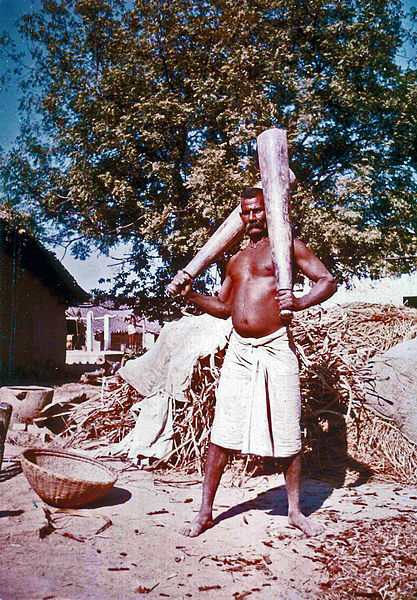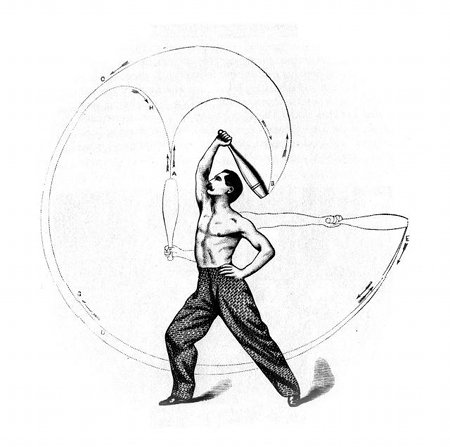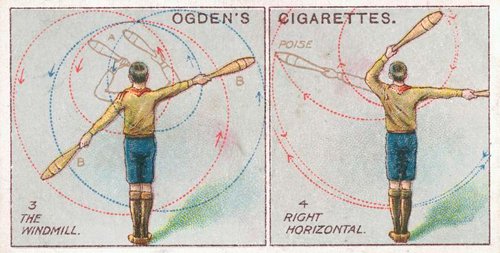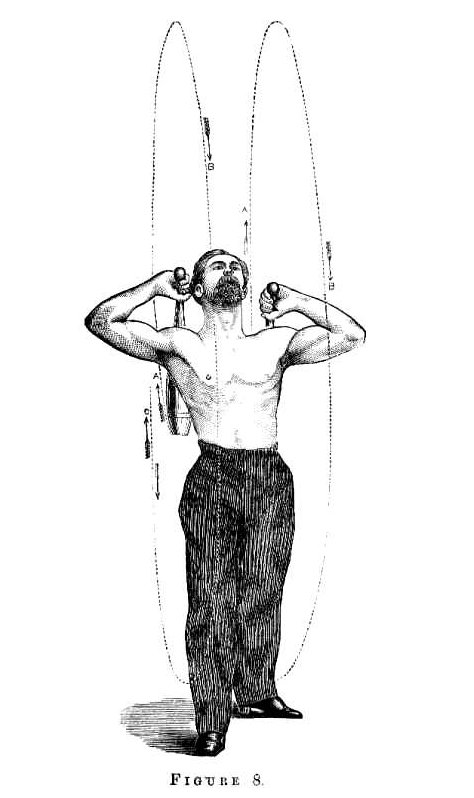
I’m always looking for new exercises to throw into my workout routine. Recently, I’ve gotten into a training method used by ancient Persian wrestlers, Victorian gentlemen, and even members of the Band of Brothers. It’s called Indian club training. You’ve probably seen people exercising with Indian clubs in old photos. Or maybe in this episode of The Simpsons. It consists of swinging weighted clubs in different and sometimes elaborate movements in order to strengthen and increase mobility in your upper body.
I’ve had a blast since giving Indian clubs a whirl and have seen my mobility in my shoulders improve as well. Below I highlight the history and benefits of Indian club training and demonstrate a few exercises to help you get started with swinging clubs.
A Brief History of Indian Clubs

Indian Pehlwani wrestler using clubs to exercise.
The practice of using clubs as a fitness tool started with ancient Persian Pehlwani wrestlers or Pehlwans. To prepare for competition and battle and to strengthen their arms and torsos, Pehlwans would swing large, modified war clubs. Pehlwani-style grappling, along with the idea of training with clubs, spread throughout Iran, India, Pakistan, and Afghanistan.
In the 19th century, British soldiers stationed in India picked up on the club swinging exercises performed by Pehlwani wrestlers and brought the practice back to England. They modified the clubs a bit to look more like modern-day bowling pins and called them “Indian Clubs.” Indian club training became wildly popular during the Victorian physical culture craze of the mid-19th century and spread throughout Europe. Soldiers and even women and children took up the exercise with gusto.

Illustration from The Indian Club Exercise, by Sam Kehoe, 1866
“Sometime during A-stage we were deep into a set of “Indian clubs” when my eyes got blurry. Indian clubs were a popular exercise device of the era. They were shaped like bowling pins and weighted at the ends. They loosened and strengthened your arms and shoulders and could be deceptively strenuous. We swung them around in various patterns until we nearly keeled over–we did them so long the clubs felt almost hypnotic after awhile.” – Buck Compton on basic training at Camp Toccoa, from Call of Duty: My Life Before, During and After the Band of Brothers
Indian club training came to the United States by way of German immigrants in the middle of the 19th century. Several popular physical culture enthusiasts evangelized for the myriad of benefits Indian club training offered and found a receptive audience in the American public. The U.S. Army included Indian club exercises as part of soldiers’ physical fitness routines during basic training in WWI. School children often took part in large, choreographed Indian club routines not so much for physical fitness, but rather for show. Turn of the century athletes were so nuts for swinging Indian clubs that it even became an official sport at the 1904 Olympics.
Indian clubs continued to be used in both gymnasiums and military boot camps into the 1930s, but waned in popularity mid-century as other pastimes like basketball, baseball, and football captured the public’s attention. But in the past decade, Indian club training has experienced a revival, especially among martial artists who find the shoulder-strengthening benefits of Indian club swinging to be particularly useful.
The Benefits of Indian Club Training

Shoulder strength and flexibility. This is perhaps the biggest benefit of Indian club training. As you know, your shoulder sits in a socket and has a wide range of motion. Unfortunately, most strength training exercises that target the shoulders, like the shoulder press, employ a very limited range of movement. Indian club training ensures you work your shoulders using their full range of motion, thus providing more complete shoulder strength and flexibility. If you’re involved in any sport that requires strong, flexible shoulders (and elbows too) like baseball, martial arts, and tennis, you’ll definitely benefit from Indian club training.
Grip and forearm strength. I was surprised how quickly my forearms began to burn when I first started swinging clubs. Holding a weight that’s at the end of a handle requires ample forearm strength. Also, holding onto the clubs so they don’t go flying out of your hands mid-swing helps you build a grip like a vise.
Core strength. The swinging motion requires you to engage your core muscles in order to stabilize your trunk.
Body coordination. Some of the more advanced Indian club swings require highly developed body coordination skills. I feel like a complete spaz doing some of them and have knocked myself in the brain canister a few times as I’ve learned new movements. But I’ve gotten better with practice. In fact, the body coordination benefits were a big reason why the U.S. Army had soldiers train with Indian clubs. According to the 1914 U.S. Army Manual of Physical Training: “The effect of these exercises, when performed with light clubs, is chiefly a neural one, hence they are primary factors in the development of grace and coordination and rhythm.” So not only are you working your shoulder muscles, you’re working the old noodle, too.
Cardiovascular exercise. Once you have a set of moves mastered, you can create a non-stop routine where you transition from exercise to exercise quickly. All that arm flailing can really get your heart going.
Great for rehab and prehab. If you’re nursing an injured shoulder or other upper body muscle, performing slow and controlled Indian club exercises are a great way to rehab. And many therapists recommend Indian club training as a way to “prehab” or prevent injuries from happening in the first place.
It’s fun! I like training with Indian clubs because it’s really quite fun. The challenge of mastering the various swings serves as motivation to keep working with the clubs. I always feel great when I finally get the hang of a new movement.
Getting Started with Indian Clubs

Buy the clubs. You can find Indian clubs on Amazon or other fitness supply stores. I bought this pair of clubs myself. They’re a bit pricey, but they’re handmade in the U.S. from pure maple. When I’m not using them, they actually look kind of nice standing in my living room. When purchasing your clubs, keep in mind that a weighted club feels way heavier than the same weight in another form. When I was choosing which clubs to buy, I imagined the 3-lb dumbbells at the gym–the ones only the elderly and infirm use–and thought, “Pffft, hefting 3-lb clubs will be a breeze!” Boy, was I wrong; I’m in relatively good shape, but I found the three pound set pretty tough to work with. I probably should have gone with the two pound set. I recommend starting off with the lightest set possible and working your way up.
Find a place with plenty of space. You’ll need enough room to fully swing your arms and clubs in all directions. Make sure you don’t have any stray toddlers walking into your swinging space. Also, avoid places with televisions and windows. You don’t want to break anything with an accidental flying club.
Learn some movements. If you’re looking for old-school, Indian club movements, you can’t go wrong with the book The Indian Club Exercise by Sam D. Kehoe. It was written in 1866 and contains 20 different diagrammed movements. It takes awhile to decipher the diagrams sometimes, and some of them still have me scratching my head a little, but several will make sense immediately.
Below I’ve included a video of me making a fool of myself showcasing a few basic Indian club exercises. Enjoy:
Do you have any experience with Indian club training? Share your tips with us.
Комментариев нет:
Отправить комментарий